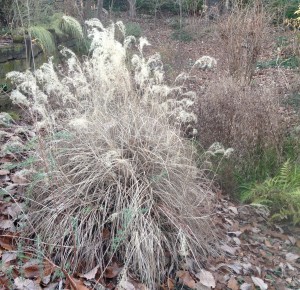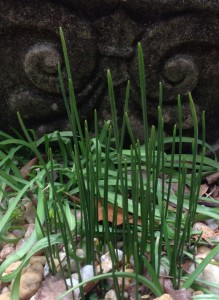
See the green growth at the base of this snapdragon?
February is usually the month the temperatures begin to rise, though there is always the possibility of cold weather still through March. This year it’s definitely been colder than usual, and the pretty pansies, snapdragons, and other cool season annuals we all planted last fall have definitely taken a hit.

These pansies need to be deadheaded – they have cold damaged blooms and buds…
Normally in February, regular deadheading (pinching off faded blooms) should be done to keep pansies and violas blooming well. Many of the snapdragons you planted will still be green at the bottom, but have dead growth that needs to be clipped off. With temperatures moderating and even rising, they will begin to grow again. In fact, they may be prettier than ever late spring into early summer; think of the cold damage as a rejuvenating pinching back!

Mondo grass, prior to being cut back with a string trimmer…
Mid-February is the traditional time to cut back mondo grass, liriope, and acorus in your landscape before spring growth begins. A string trimmer makes quick work of this job. Don’t wait too long to take care of this necessary grooming maintenance or you’ll risk damaging new growth.

This big clump of miscanthus needs to be cut down to make way for fresh growth…
Do you have tall perennial grasses in your landscape? They should also be cut back now. The easiest way to address large clumps of grasses is to bundle them up with strong twine or a bungee cord, then, if it’s a small clump, cut it back with your hand pruners. Or, if the clump is large, use a power hedge trimmer and simply cut the entire clump to the ground. Again, don’t wait too long to tackle this chore or the new spring growth will already be up. Be very careful with these large perennial grasses; wear long sleaves to protect your arms and glasses to protect your eyes from the sharp grass blades.
It’s still a bit early to fertilize shrubs and trees in anticipation of spring growth – that is best left for the end of March into April. However, if you didn’t shred your leaves this fall and work them into garden beds, resolve to do it this year. Adding any organic matter to beds helps loosen soil and provides nutrients, contributing to the overall health of your soil and microbes that live in it.

These 4’x8′ beds are just the right size for a few veggies…
Have you been thinking about creating a new bed in your landscape? It’s a great time to do this as well. Perhaps you’d like to have a vegetable garden this spring. Even a small area of 4’x8′ can provide enough space to grow a couple of tomato plants or some peppers or a combination of a few different things.
The one thing to remember when making a new planting bed is you must add organic matter to our clay soil – leaf mulch, cow manure, soil conditioner, homemade compost (Do you have a compost pile? You should!). Work as much organic matter as possible into your new bed. This will aid in drainage and soil fertility and make it easier to plant too! If you have old newspapers, these can be laid over the top of your bed and a thick layer of mulch or leaf mold placed on top. Not only does the newspaper smother weed seeds you may have brought to the surface but it will decompose – the perfect way to recycle your newspaper!

Narcissus ‘Baby Moon’ foliage beginning to come up through the ipheion…
You may have perennial bulbs appearing in your garden. As this foliage emerges, it is the time to fertilize them with a bulb fertilizer. If they seem crowded and don’t bloom well, consider dividing into smaller clumps this spring.
Taken a bit at a time, these tasks aren’t too demanding, and the deadheading, cutting back, and fertilizing will make your landscape shine!
